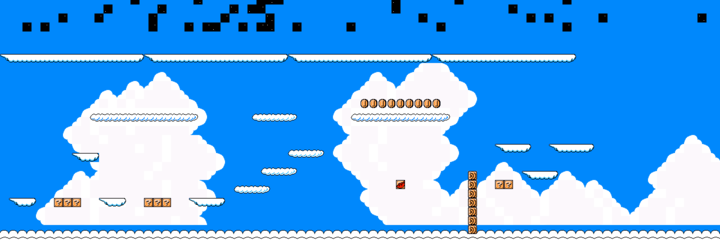Daily news, dev blogs, and stories from Game Developer straight to your inbox
Sponsored By
Atmosphere in Games - Part 8 - World design and level progression
Part 8 in a 10-part series about atmosphere in games - what it is, how to improve it, and how it breaks down into the various aspects of a game.
6 Min Read


level
What's the point in having a game look and sound great if it doesn't look and sound consistent? Again, this depends on what you're developing the game for and to feel like. But if you want some atmosphere in a game, it helps if the level design realistically progresses or stays similar for the whole game. The reason for this is a tie-in to the previous article - in real life, we don't jump from fire area to water area to forest area instantaneously. Something in our brain gets wise to this and stops immersing itself.
So when you go from your lava level to your water level - maybe you want to put a transition level in between? Of course, this doesn't matter if you're just doing a fun, anything-goes style of title - Rayman Origins springs to mind - but if you're serious about creating a mood, keep your game's level-design in check. Ramp up the rate-of-change as the game progresses, or (as many indie titles do) keep the level design consistent throughout the entire game.
I'm all for progression, personally, the reason being that I think it matches the plot/character arcs that an atmospheric game will typically have (even voiceless, textless games still tend to have implicit narrative arcs). More on this next article. So if you're going to progress, do it within the world context. Like Diablo 1, gradually change your environment as you progress deeper into the game. Not only does this give an emotional reward to the player (who feels like they are making progress not just on some technical level but on an experiential level too) but it creates a more effective climax, if there is one, in the game. It also Feels realistic. Some games, like Psychonauts, get around this emotional-realism-limitation by having a mechanic which thoroughly explains the radically-different world designs while still being completely within the realistic context of the characters and the overall world. However, most independent games aren't quite so radically innovative and do not have the budget to invest in being both correct in terms of realism and in terms of narrative depth.
Another example of this is dream-sequences - used both in games and other mediums to create differentiating and more surreal areas which turn the reality of the world on it's head - however these are only effective if there is an established world to turn over. In the case of most games, a dream sequence would only be cautiously effective as the gameworld itself does not feel real and engrossing enough to create contrast. There are other examples - getting sucked into the neural net of the Geth in Mass Effect 3, psychic invasion levels in Metro 2033 - as long as these fit within the overworld and don't dominate the game, they both contrast and highlight the original world. But there is a 'world of difference' between that and "forest, ice level, water level, desert level" - that's just bad game design if you're looking for atmosphere.
Another aspect of atmospheric level design that's worth exploring is psychological involvement. In Diablo, the levels gradually become more and more hellish, the further you descend into the earth - psychologically, this can feel like going further and further into a part of yourself you don't want to explore - many horror games play with this concept to some extent. These psychological links were made fairly explicit in Spec Ops: The Line, where the line between mental health and game level was purposefully blurred. Most areas in our real lives have psychological connotations. Forests can be enchanting but dangerous and primordial. Our homes and neighbourhoods have elements of comfort, protection and territoriality associated with them, internally. You can play with these concepts when you think about where best would suit your level, depending on where the characters and plot are at emotionally.
Lastly I'll mention that the world -is- the atmosphere. However quirky/dark/light/serious you internally believe the game to be, that atmosphere should be reflected not just in the game design but in the world and level design. Doom 1 was a great example of this, reflecting it's otherworldly and demonic aspect in a level design which seemed to intentionally toy with and bewilder the player. Your level design is not mud - it is bricks and mortar which reinforce the gameplay and the overall 'feel of your game - it's something you use to build atmosphere.
Games that do this well
Diablo 1 (AAA, payware): As stated above. Bar the obvious colour-cycling for 'new' monsters.
Metro 2033 (AAA, payware): The dark, forbidding underground of the Metro provided both gameplay and psychological uniqueness. And the quick visits to the surface did nothing to dull the atmosphere, instead providing a psychological and experiential contrast that totally fitted the gameworld.
Spec Ops: The Line (AAA, payware): Much has been made about the significance of sand in this game - the psychological horror, the gritty line between paranoia and fantasy. But nobody has mentioned how consistently 'in the world' the game felt, and how well it progressed while retaining both a sense of realism and psychological horror.
Games which don't do this as well
Bastion (Indie, payware): I'd say I enjoyed this game, as the mechanics were fun and the characters, while brief with their words, added texture to an already engaging world. However, as far as level realism and progression went, I never felt entirely sold on why the blocks of land arranged themselves in place before I stepped on them, and the game never explained it - merely a unique game mechanic. That and the fact that the transition between levels felt poorly-explained and 'jumpy'. Then, the dream sequences provided little contrast to the game itself, being more-or-less the same type of level but with different goals. However much I enjoyed the game, I still found it 'technical'-feeling for the above reasons and lacking in a sense of immersion.
Games which fall outside of above logic
Rayman Origins (AAA, payware): Now, I'll be the first to say it - this game doesn't need to be realistic. If you play all the way through to the end you get the strange feeling that the whole thing was a dream someone sleeped in, and you just played through it. However. The opening of the game does show a very specific plot sequence. That sequence is never touched upon in the subsequent actual levels. And the levels do tend to jump from ice world to fire world, with no intervening transition sequences or levels. But the music, graphics and gameplay all give the game such a sense of childlike wonder, imagination, and yes, atmosphere, that it's hard not to get engrossed in it. If they'd worked hard to provide proper level progressions and plot-arcs, yes, it would be ten times more grounded - but the atmosphere of this title isn't provided by feeling grounded, or understanding things. It's about wackiness, feeling spaced out, overstimulated and out-of-control. The game wouldn't be the game it is if someone hadn't decided to just throw out the chocolate-covered-rainbow-baby with the flourescent-neon-nightglow-bathtub.
Read more about:
BlogsAbout the Author(s)
You May Also Like







.jpeg?width=700&auto=webp&quality=80&disable=upscale)








